Feast Day: July 22nd
Here’s the story in a nutshell: Prostitute falls in love with The Man and is saved. You saw Pretty Woman, right? How about Leaving Las Vegas? You got it: the story of St. Mary Magdalene is the original tale of the hooker with a heart of gold. She is the model of penitence, which for all you illiterates means that she feels badly for her sins. She actually appears in the Bible… a few times… sort of. There was a lady who anointed the feet of Jesus and there was a sister of Martha and there was the gal from whom Jesus exorcized seven devils and there was the Mary at the Crucifixion and so the church in Rome kind of rolled them into one St. Mary Magdalene. Dan Brown, the author of the Da Vinci Code, suggested many things about St. Mary Magdalene, including that she was married to Jesus, but that’s nutty. Ignore it.
In all of the stories about St. Mary Magdalene, one theme rises to the top: she was a devoted follower of Jesus – a true and humble believer. First, she runs into Jesus at a dinner party with Simon and, feeling all badly about herself, she starts blubbering as she put oil of myrrh on his feet. Then, when Jesus drops in on St. Mary Magdalene and her sister Martha’s house, St. Mary Magdalene hangs out to listen to Jesus rattle on instead of cooking and cleaning for the guest. Martha gets bent out of shape, but Jesus told St. Mary Magdalene that she did the right thing. When Jesus is in the house, you have to listen! Honestly, why else is he there? Finally, when she was inconsolable after Jesus died, He came to her and said “Noli me tangere,” which means, “Don’t touch me!” He then told her to go tell his disciples that he’s baaaack. The point is that she was such a true believer that he chose to visit her before anyone else.
According to the Golden Legend, St. Mary Magdalene spent the end of her life in Provence, which is an excellent place to retire. Apparently, she spent about thirty years in the wilderness there and no less than SEVEN times a day angels swooped down and carried her to heaven for a sneak peek of the good life. In the thirteenth century somebody said they found her relics there and her cult grew rapidly. There are oodles of images of St. Mary Magdalene in art since there are many stories about her that an artist could tell.
St. Mary Magdalene in Art
Here is your basic, portrait-type image, often associated with penitence. Her attribute is the little ointment jar. Note how hairy she is. Ladies of ill-repute wore their hair down and apparently nothing else. Sexy, huh?
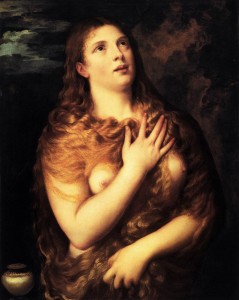
Titian, St. Mary Magdalene, c. 1532, oil on panel, 33.1” x 27.2”, Palazzo Pitti, Florence, Public Domain via Wikimedia Commons.
Here she looks as if she walked right off the set of Swamp People.
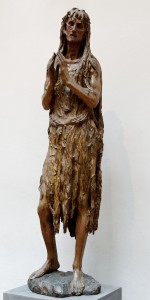
Donatello, Mary Magdalene, 1454-1455, poplar wood, polychromed and gilded, 89”, Opera di S. Maria del Fiore, Florence, Photo by Marie-Lan Nguyen via Wikimedia Commons, Creative Commons Attribution 2.5 Generic License.
Here is the ultimate penitent Mary Magdalene. The skull is there to remind you that, like everyone else, you will die so you’d better shape up! The candle will burn out and so will you and you won’t have a sorry face to look at anymore!
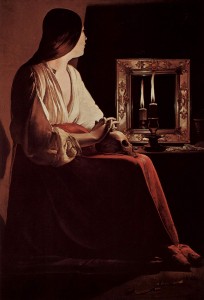
Georges de la Tour, The Penitent Magdalene, 1638-1643, oil on canvas, 52.5” x 40.2”, The Metropolitan Museum of Art, New York, Photo by The Yorck Project: 10.000 Meisterwerke der Malerei via Wikimedia Commons.
Up and down, up and down, up and down – here she is on one of her seven daily trips to heaven.
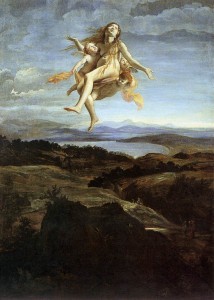
Giovanni Lanfranco, Assumption of St. Mary Magdalene, c. 1616, oil on canvas, 42.9” x 30.7”, Museo e gallerie nazionali di Capodimonte, Naples, Public Domain via Wikimedia Commons.
Here’s one that shows the moment after the Resurrection when Jesus tells Mary Magdalene not to touch him. Notice he has a shovel. This is because Mary Magdalene originally thought he was a gardener. I don’t know why. How many naked gardeners donning a halo do you know?
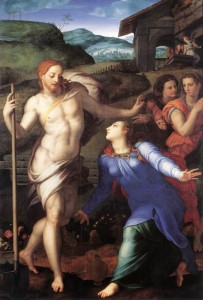
Agnolo Bronzino, Noli me tangere, 1561, oil on panel, 114.6” x 76.8”, Musée de Louvre, Paris, Public Domain via Wikimedia Commons.
This is great: Jesus with two hoes. Looks like he’s after something there.

Attributed to Pontormo, after drawings by Michelangelo, Noli me tangere, 1530s, oil on panel, 49.2” x 37.4”, Private Collection, Public Domain via Wikimedia Commons.
Here is a painting of Jesus in the House of Mary and Martha. It looks like a painting of a bunch of raw meat and stuff on a table, but it’s not! The trick is to find the REAL meaning of the picture, which is to listen to Jesus… although a little cleaning wouldn’t hurt. Those girls are slobs!
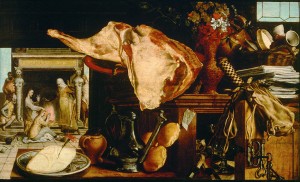
Pieter Aertsen, Vanitas Still Life, 1552, oil on panel, 23.62” x 39.96”, Kunsthistorisches Museum, Vienna, Public Domain via Wikimedia Commons.
Get a hold of yourself, woman! You are making a spectacle of yourself!
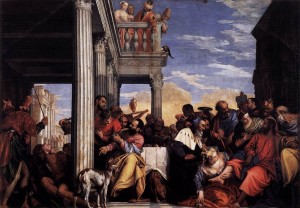
Paolo Veronese, Feast in the House of Simon, 1560, oil on canvas, 124” x 177.6”, Galleria Sabauda, Turin, Public Domain via Wikimedia Commons.
This is so good! Look at St. Mary Magdalene at the bottom of the cross. She would have to love Jesus to get that close to those feet.

Matthias Grünewald, detail of the Isenheim Atarpiece, c. 1515, oil on panel, Musée d’Unterlinden, Colmar, Photo by The Yorck Project: 10.000 Meisterwerke der Malerei, via Wikimedia Commons.
If you want to buy some trinkets with St. Mary Magdalene on them, click here.